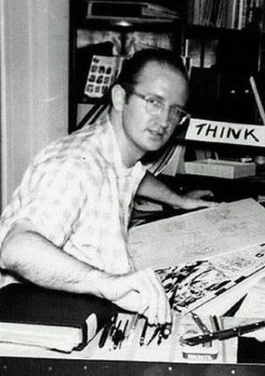
Stephen John Ditko was an American comics artist and writer best known for being the co-creator of Marvel superhero Spider-Man and creator of Doctor Strange. He also made notable contributions to the character of Iron Man, revolutionizing the character's red and yellow design.

The Human Torch, also known as Jim Hammond, is a superhero appearing in American comic books published by Marvel Comics. Created by writer and artist Carl Burgos, he first appeared in Marvel Comics #1, published by Marvel's predecessor, Timely Comics.

Timely Comics is the common name for the group of corporations that was the earliest comic book arm of American publisher Martin Goodman, and the entity that would evolve by the 1960s to become Marvel Comics.
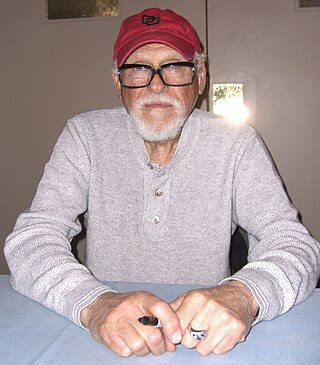
Eugene Jules Colan was an American comic book artist best known for his work for Marvel Comics, where his signature titles include the superhero series Daredevil, the cult-hit satiric series Howard the Duck, and The Tomb of Dracula, considered one of comics' classic horror series. He co-created the Falcon, the first African-American superhero in mainstream comics; Carol Danvers, who would become Ms. Marvel and Captain Marvel; and the non-costumed, supernatural vampire hunter Blade.

Donald L. Heck was an American comics artist best known for co-creating the Marvel Comics characters Iron Man, the Wasp, Black Widow, Hawkeye and Wonder Man and for his long run penciling the Marvel superhero-team series The Avengers during the 1960s Silver Age of comic books.

The Thunderer is a superhero appearing in American comic books published by Timely Comics.
M. F. Enterprises was a 1966–67 comic book publisher owned by artist and 1970s pulp-magazine entrepreneur Myron Fass, whose holdings also included the black-and-white horror comics magazine imprint Eerie Publications.

Vision (Aarkus) is a superhero appearing in American comic books published by Marvel Comics. Created by the writer Joe Simon and artist Jack Kirby, the character first appeared during the Golden Age of comic books in Marvel Mystery Comics #13, published by Marvel predecessor Timely Comics.
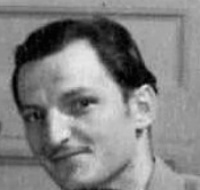
Donato Francisco Rico II was an American paperback novelist, screenwriter, wood engraver and comic book writer-artist, who co-created the Marvel Comics characters the Black Widow with plotter Stan Lee and artist Don Heck; Jann of the Jungle with artist Arthur Peddy; Leopard Girl with artist Al Hartley; and Lorna the Jungle Girl with an artist generally considered to be Werner Roth. His pen names include Dan Rico, Donella St. Michaels, Donna Richards, Joseph Milton, and N. Korok.

The All-Winners Squad is a fictional superhero team appearing in American comic books published by Marvel Comics. The company's first such team, it first appeared in All Winners Comics #19, published by Marvel predecessor Timely Comics during the period fans and historians call the Golden Age of Comic Books.

Atlas Comics was the 1950s comic-book publishing label that evolved into Marvel Comics. Magazine and paperback novel publisher Martin Goodman, whose business strategy involved having a multitude of corporate entities, used Atlas as the umbrella name for his comic-book division during this time. Atlas evolved out of Goodman's 1940s comic-book division, Timely Comics, and was located on the 14th floor of the Empire State Building. This company is distinct from the 1970s comic-book company, also founded by Goodman, that is known as Atlas/Seaboard Comics.

Marvel Super-Heroes is the name of several comic book series and specials published by Marvel Comics.

Stingray is a superhero appearing in American comic books published by Marvel Comics. Created by Roy Thomas and Bill Everett, the character first appeared in Tales to Astonish #95. Stingray is an engineer and oceanographer.
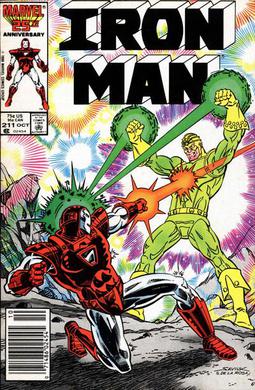
The Living Laser is a supervillain appearing in American comic books published by Marvel Comics. Created by Stan Lee and Don Heck, the character made his first appearance in The Avengers #34. He would become a recurring enemy of Iron Man and plays a key role in the "Iron Man: The Inevitable" miniseries.
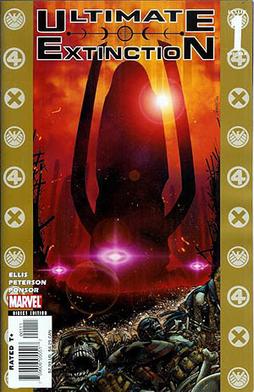
The Ultimate Galactus Trilogy is a collection of three comic book limited series published by Marvel Comics. All three series are set in the Ultimate Marvel universe and are written by Warren Ellis. The series showcase the arrival of the planet-eating entity Gah Lak Tus on Earth.

Frankenstein's Monster is a fictional character appearing in American comic books published by Marvel Comics. The character is based on the character in Mary Shelley's 1818 novel Frankenstein; or, The Modern Prometheus. The character has been adapted often in the comic book medium.
Vision is the name of three fictional characters from Marvel Comics. The original character originated in Marvel's predecessor Timely Comics and is depicted as an extra-dimensional law enforcement officer; the latter two are humanoid androids. The original first appeared in Marvel Mystery Comics #13 in 1940.

Space Adventures was an American science-fiction anthology comic book series published sporadically by Charlton Comics from 1952 to 1979. Its initial iteration included some of the earliest work of industry notables Steve Ditko, Dick Giordano, and Tony Tallarico, and at least one story by EC Comics mainstay Bernard Krigstein.

Fantastic Four is the name of several comic book titles featuring the team the Fantastic Four and published by Marvel Comics, beginning with the original Fantastic Four comic book series which debuted in 1961.

The Destroyer is the name of three fictional superheroes appearing in American comic books published by Marvel Comics. The original incarnation was created by writer Stan Lee and artist Jack Binder and first appeared in Mystic Comics #6, being one of Lee's earliest creations during the Golden Age of Comic Books.


















